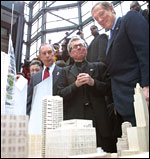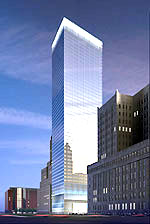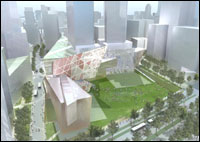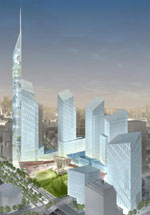Early one morning last month, over fresh-squeezed orange juice and silver platters of breakfast treats, a coterie of New York’s leading architects, developers, politicians, and environmentalists convened in a chandeliered room at the Embassy Suites hotel in lower Manhattan for a conference entitled “Greening Our Downtown.” The keynote speaker was Gov. George Pataki (R), who was there to receive an award from the U.S. Green Building Council for his efforts to promote green buildings in his state and, in particular, in downtown New York City.

New York City Mayor
Michael Bloomberg,
architect Daniel Libeskind,
and Gov. George Pataki.
Photo: New York
governor’s office.
The USGBC, which hosted the event, presented Pataki with a sculpture of an oak tree with leaves of glittering green stone — a camera-friendly token of appreciation in an event marked by the predictable quantity of photo-ops and sound bites. But amid the posturing, a few ideas of surprising substance, even sweeping vision, emerged: First, that more than any other resource-intensive industry (including the one based in Detroit), the building industry is poised to make tremendous strides in energy efficiency and the adoption of clean technologies in the next five to 10 years. Second, that downtown New York — and in particular the World Trade Center site — can and should become a model of green building that accelerates a worldwide shift toward sustainable building and alternative energy.
Before getting into the details of how these visions could play out, I must confess not only that I am a card-carrying member of the USGBC, but also that I helped to organize the conference. So much for my journalistic impartiality, you say, but the truth is that I am something of an imposter in the green-building world: My interest has never really been in the buildings themselves, but in the energy technology they can showcase. Given my energy-centric attitude, it was somewhat troubling to discover at the conference that renewable energy is just a small twinkle in a vast constellation of green-building components.
Take the Green Building Council’s Leadership in Energy and Environmental Design rating system, which is the industry standard in certifying green buildings. The LEED system assigns new buildings up to 69 total points: A basic LEED “certified” rating requires at least 26 points, a “silver” rating requires at least 33 points, “gold” requires at least 39 points, and “platinum” requires 52 points, or 75 percent of the maximum possible. Points are awarded in six different categories: site selection, water efficiency, materials and resources, indoor environmental quality, energy and atmosphere, and innovation. Within these categories, points can be awarded for features ranging from the inclusion of a bicycle room and a non-smoking clause in the building to installing carbon dioxide monitors in conference rooms (poor ventilation leads to high CO2 levels) and, oh yes, solar panels on the roof.
Unfortunately for alternative-energy buffs, on-site renewable energy generation can fetch a developer a maximum of three points in the LEED system (one point for generating 5 percent of the building’s total energy demands, two points for 10 percent, and three points for 20 percent). Furthermore, the developer can only get one point for buying green power from the grid. The limited importance of clean energy measures in the LEED system could have a significant impact on the redevelopment of downtown Manhattan.

The proposed World
Trade Center 7.
Image: Advanced Media
Design and Skidmore
Owings Merrill.
A case in point is the redevelopment of World Trade Center 7, which will be the first building at the site to be rebuilt (it has a different architect than the central Ground Zero complex) and is already in the final planning stages. Even though developer Larry Silverstein has registered the building for LEED certification, energy efficiency and renewable energy have been almost completely overlooked in the building design. “World Trade Center 7 will barely meet efficiency codes,” says Ashok Gupta, the Natural Resources Defense Council’s leading energy economist, who has been consulting on the project. “The problem is that developers can get LEED certification without addressing energy issues at all. They can accumulate enough points in the other categories to make the cut.”
Although all the major decision-makers involved in the rebuilding of the World Trade Center (including architect Daniel Libeskind, developer Larry Silverstein, the Lower Manhattan Development Corporation, and the Port Authority of New York and New Jersey) have spoken publicly about their commitment to sustainability, none has commented directly on the matter of renewable energy. At the “Greening Our Downtown” conference, Joseph Seymour, the director of the Port Authority, pledged to commit “nearly $100 million to the sustainable design components” at the site. The sum wowed the audience and is surely commendable — “It’s without a doubt enough to enough to make these buildings models of exceptional efficiency and on-site photovoltaic applications, if that were the priority,” says Gupta — but alt-energy wonks shouldn’t get too excited. The redeveloped World Trade Center complex could easily go the way of its sibling building at WTC 7, with those funds absorbed by other areas such as recycled materials, air filtration systems, and access to mass transit.
Greg Trevor, a spokesperson for the Port Authority said, “We are considering things like recycled materials, an energy-efficient electrical system, natural day-lighting, and improved indoor air quality.” All good ideas — but nary a peep about a state-of-the-art cogeneration system for efficient heating and cooling or renewable energy. When I asked Irene Chang, a principal at the Lower Manhattan Development Corporation, whether there had been any discussion about whether to include on-site solar panels she said flatly, “No. It’s too early to address these details.”
Ground Net Zero?
Be that as it may, there’s a strong case to be made that these funds should be used to make Ground Zero the El Dorado of efficiency and clean energy. As improbable as it may seem, New York, which scores poorly on many other urban environmental issues (diesel exhaust, skyrocketing asthma rates, and so forth), has a strong hand when it comes to energy. The city has the lowest per-capita energy use of any city in the nation, thanks to its population density and mass-transit system. Most New Yorkers live in homes that are a fraction of the nationwide average (requiring less energy to heat and cool), and the vast majority travel to work via public transit, resulting in tremendous energy savings by commuters. “You’ve got in New York City the model of the future,” says Randolph Croxton, a leading green architect based in Manhattan. “All human settlements are moving inexorably toward a densely developed urban model, and from an environmental standpoint, no urban model surpasses the inherent energy efficiency of New York City.”
All the more reason to improve upon that model. The buildings at the World Trade Center site will be among the most visited and visible buildings in the world. As such, they offer an unsurpassed opportunity to make an international statement about America’s energy future. “The best way to enhance our security, make us better global citizens, reduce our dependence on Middle East oil, and leave a better planet for our kids is a Manhattan Project to develop renewable energy sources, along with greater conservation,” wrote New York Times columnist Thomas Friedman last October. The opportunity for such an initiative lies, appropriately, at the foot of Manhattan. What could be a more effective a memorial to the tragedies that took place here in the past than one that points us in the direction of a sustainable energy future?

The proposed World Trade
Center.
Image: Studio Daniel Libeskind.
The NRDC’s Gupta estimates that energy-saving measures such as glazed windows and efficient lighting, boiler, and HVAC systems, as well as motion-sensing lasers that automatically switch off lights and appliances when not in use, could make the new World Trade Center complex up to 50 percent more energy efficient than the original buildings, which guzzled nearly 100 megawatts of electricity on peak load days.
It’s a short leap from a scenario in which the new World Trade Center consumes half the energy of the original to a scenario in which it has enough on-site generation to be a net-zero energy complex. Imagine the new, efficient buildings sheathed in a skin of solar cells that generate 20 percent of the complex’s total energy needs, pumping clean electricity into the buildings during the day, when the sun is shining, air conditioners are cranking, and energy demand is peaking. With fuel cells and clean, natural-gas-powered micro-turbines on site to power the rest of the buildings’ energy needs, the complex would be completely independent of the grid much of the time. (This would protect it from blackouts, an increasingly serious threat, as New York City’s electricity demand is growing at roughly 2 percent per year). The complex would also be connected to the grid — drawing electricity when necessary at night or on cloudy days, and pumping power back in when it creates a surplus.
The new complex could also be a net-zero emissions development. To offset all emissions related to the buildings’ onsite micro-turbines and the grid-connected electricity they consume, the developers could buy the equivalent amount of clean electricity elsewhere — say, via solar panels on buildings in surrounding neighborhoods or a wind-farm in upstate New York. The complex and its surrounding neighborhood could have a fuel-cell-powered bus fleet and minimal need for cars and trucks. The area could be knitted together by a clean, quiet street grid restored for use by pedestrians only. The West Side highway could be sunk underground. The region’s three airports (Kennedy, LaGuardia, and Newark) could be connected by train to the downtown terminal, making it an easy public-transit trip to the complex for out-of-towners. An expanded network of ferries connecting Lower Manhattan with Brooklyn, Queens, New Jersey, and uptown Manhattan could provide a fast and pleasant way to get around.
This Little Solar Panel Went to Market
Admittedly, this vision would be cost a pretty penny to execute, and green building advocates are sensitive to cost. They want the development community at large to accept green building as a market-friendly proposition — a sound investment that will have a reasonable payback period, rather than a charity case requiring substantial subsidies.
Part of the reason there is so little emphasis on renewable energy is that it is perceived as prohibitively expensive; solar still requires substantial subsidies to be cost-competitive with traditional sources of energy. Although the high initial cost of renewable energy would eventually be recouped in energy savings, many green building experts see it as a potential deterrent to the near-term growth of the green-building movement. It’s true that a high-profile demonstration project at Ground Zero might go a long way to turn heads and educate the public — and eventually to create demand for more buildings like it — but the steep initial costs could also send a signal to the building industry that green projects are financially cumbersome and only possible with substantial subsidies.
“Remember that we are trying to create markets,” says Christine Ervin, president and CEO of the USGBC, “which means we can’t get too hung up on regulations and subsidies. Government can help create markets by working with private industry in partnership to create some tax incentives and streamline certification processes, but what will really drive the adoption of green standards in the marketplace is the fact that they make good business sense.”
But shouldn’t building developers be amenable to the long-term payback of alternative energies — more so than, say, automobile entrepreneurs, given that a building is an investment that lasts 100 years, whereas a car is an investment that lasts, on average, 10 years? Sure, in an ideal world. But with gray water and compact fluorescent light bulbs and recycled building materials and bamboo flooring and bicycle rooms to consider, developers have enough to worry about without the added concern of renewable energy.
And, needless to say, these other aspects of green building should not be belittled. After all, the built environment consumes over 40 percent of all natural resources in the United States, so the more we can diminish that footprint, the better. And unlike renewable energy, many of these other environmental improvements can be done at very little added cost; to get a LEED silver certification on a commercial building costs on average 0 to 3 percent more than constructing a conventional building.
“LEED is the single most powerful market-transformation tool I’ve ever encountered, in part because it’s enabling developers to come up with ways to build green buildings in an economically feasible way,” said Ervin. “It works because it’s not prescriptive. It enables developers to approach the challenge of green building in a way that works well for them.” Ervin adds that the cheaper and more mainstream renewable technologies become, the more USGBC will likely be able to emphasize them as a priority in the LEED points system. Indeed, largely because of this sensitivity to what’s cost-effective, LEED certification is catching on like wildfire. At the end of 2001, there were 275 major commercial buildings in the U.S. registered for LEED; today there are 842.

Another view of the
proposed World Trade
Center complex.
Image: Studio Daniel
Libeskind.
Let’s hope that the World Trade Center redevelopment project becomes number 843. There is no question that $100 million could go a long way toward making an impressive showcase of green building, even if energy efficiency isn’t the signature innovation. So long as solar power is four times more expensive than traditional energy, it will be hard to make a good economic argument for a WTC complex that is fully sheathed in solar cells. Perhaps BP could be convinced to donate the panels, in what would surely amount to one of the best publicity stunts of all time.
But even without such dramatic stunts, we shouldn’t despair about the radical potential of the rebuilt complex. “Hopefully this project will be designed with the intelligence to make a transition to 100 percent renewables down the line,” says Croxton, the environmental architect who has been advising the Port Authority on sustainability concerns in the World Trade Center redevelopment. “It doesn’t all have to happen up front. We can build these buildings so that they are set up with the intelligence to gracefully move from the economically viable energy systems of today into clearly near-threshold systems we see beginning to become viable. These buildings will last over 100 years, and they can be built to evolve and adapt to the times.”

